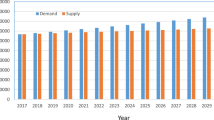Abstract
Completing a residency program is a requirement for medical students before they can practice medicine independently. Residency programs in internal medicine must undergo a series of supervised rotations in elective, inpatient, and ambulatory units. Typically, a team of chief residents is charged to develop a yearly rotational schedule. This process is complex, as it needs to consider academic, managerial, regulatory, and legal restrictions while also facilitating the provision of patient care, ensuring a diverse educational experience, balancing the workload, and improving resident satisfaction. This study proposes (1) a multi-stage multi-objective optimization approach for generating yearlong weekly resident rotation schedules and (2) the use of Analytical Hierarchy Process (AHP) to compare schedules across multiple criteria to select those that are more equitable and hence to facilitate their adoption and implementation. Furthermore, the proposed approach allows the scheduling of periodic clinic rotation schemes that are commonly used to facilitate continuity of care, such as “4+1” or the “8+2” policies. In the “4+1” policy residents rotate for four consecutive weeks in different units prior to return for a week to a predetermined clinical post. Similarly, in the “8+2” policy, residents rotate eight weeks across multiple units before doing a two week rotation at a predetermined clinic.





Similar content being viewed by others
References
Accreditation Council for Graduate Medical Education. ACGME Program Requirements for Graduate Medical Education in Internal Medicine-Pediatrics. http://www.acgme.org/LinkClick.aspx?link=PFAssets%2fProgramRequirements%2f700_med_peds_07012013.pdf&articleId=4993 2013
Bard JF, Shu Z, Leykum L (2013) Monthly clinic assignments for internal medicine housestaff. IIE Trans Healthc Syst Eng 3(4):207–239
Bard JF, Shu Z, Morrice DJ, Leykum LK (2016) Annual block scheduling for internal medicine residents with 4+ 1 templates. Journal of the Operational Research Society
Bard JF, Shu Z, Morrice DJ, Leykum LK, Poursani R (2016) Annual block scheduling for family medicine residency programs with continuity clinic considerations. IIE Transactions, pp 1–15
Barger LK, Ayas NT, Cade BE, Cronin JW, Rosner B, Speizer FE, Czeisler CA (2006) Impact of extended-duration shifts on medical errors, adverse events, and attentional failures. PLoS Med 3(12):e487
Block L, Wu AW, Feldman L, Yeh H-C, Desai SV (2013) Residency schedule, burnout and patient care among first-year residents. Postgrad Med J 89(1055):495–500
Cohn A, Root S, Kymissis C, Esses J, Westmoreland N (2009) Scheduling medical residents at Boston University School of Medicine. Interfaces 39(3):186–195
Day TE, Napoli JT, Kuo PC (2006) Scheduling the resident 80-hour work week: an operations research algorithm. Curr Surg 63(2):136–141
Fletcher KE, Davis SQ, Underwood W, Mangrulkar RS, McMahon LF, Saint S (2004) Systematic review: Effects of resident work hours on patient safety. Ann Intern Med 141(11):851–857
Franz LS, Miller JL (1993) Scheduling medical residents to rotations: solving the large-scale multiperiod staff assignment problem. Oper Res 41(2):269–279
Guo J, Morrison DR, Jacobson SH, Jokela JA (2014) Complexity results for the basic residency scheduling problem. J Sched 17(3):211–223
Halbach MM, Spann CO, Egan G (2003) Effect of sleep deprivation on medical resident and student cognitive function: a prospective study. Amer J Obstet Gynecol 188(5):1198–1201
Okie S (2007) An elusive balance—residents’ work hours and the continuity of care. Engl J Med 356 (26):2665–2667
Peets A, Ayas NT (2012) Restricting resident work hours: the good, the bad, and the ugly. Crit Care Med 40(3):960–966
Satty TL et al (1980) The Analytic Hierarchy Process
Smalley HK, Keskinocak P (2016) Automated medical resident rotation and shift scheduling to ensure quality resident education and patient care. Health Care Manag Sci 19(1):66–88
Topaloglu S (2006) A multi-objective programming model for scheduling emergency medicine residents. Comput Indust Eng 51(3):375–388
Topaloglu S (2009) A shift scheduling model for employees with different seniority levels and an application in healthcare. Eur J Oper Res 198(3):943–957
Topaloglu S, Ozkarahan I (2011) A constraint programming-based solution approach for medical resident scheduling problems. Comput Oper Res 38(1):246–255
Volpp KG, Grande D (2003) Residents’ suggestions for reducing errors in teaching hospitals. Engl J Med 348(9):851–855
West CP, Tan AD, Habermann TM, Sloan JA, Shanafelt TD (2009) Association of resident fatigue and distress with perceived medical errors. JAMA 302(12):1294–1300
Acknowledgements
We thank Rochester General Hospital for supporting this study through its Kidd Grant program and for giving us the opportunity to work in this project. In particular, we express our appreciation to Dr. Richard Sterns and his team of chief residents at the Internal Medicine Residency Rotation Program at RGHS for providing us valuable data and for their feedback throughout this work. We also thank Matthew Myers for collecting on-site information that facilitated our understanding of the residency scheduling problem.
Author information
Authors and Affiliations
Corresponding author
Rights and permissions
About this article
Cite this article
Proano, R.A., Agarwal, A. Scheduling internal medicine resident rotations to ensure fairness and facilitate continuity of care. Health Care Manag Sci 21, 461–474 (2018). https://doi.org/10.1007/s10729-017-9403-9
Received:
Accepted:
Published:
Issue Date:
DOI: https://doi.org/10.1007/s10729-017-9403-9




